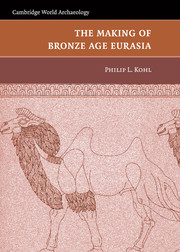Book contents
- Frontmatter
- Contents
- Illustrations and Maps
- Abbreviations
- Preface
- Frontispiece: Eurasian Steppe Zone and the Greater Ancient Near East
- 1 Archaeological Theory and Archaeological Evidence
- 2 The Chalcolithic Prelude – From Social Hierarchies and Giant Settlements to the Emergence of Mobile Economies, ca. 4500–3500 BC
- 3 The Caucasus – Donor and Recipient of Materials, Technologies, and Peoples to and from the Ancient Near East
- 4 Taming the Steppe – The Development of Mobile Economies: From Cattle Herders with Wagons to Horseback Riders Tending Mixed Herds; the Continued Eastward Expansion of Large-Scale Metallurgical Production and Exchange
- 5 Entering a Sown World of Irrigation Agriculture – From the Steppes to Central Asia and Beyond: Processes of Movement, Assimilation, and Transformation into the “Civilized” World East of Sumer
- 6 The Circulation of Peoples and Materials – Evolution, Devolution, and Recurrent Social Formations on the Eurasian Steppes and in West Asia: Patterns and Processes of Interconnection during Later Prehistory
- Appendix
- References
- Index
6 - The Circulation of Peoples and Materials – Evolution, Devolution, and Recurrent Social Formations on the Eurasian Steppes and in West Asia: Patterns and Processes of Interconnection during Later Prehistory
Published online by Cambridge University Press: 05 June 2012
- Frontmatter
- Contents
- Illustrations and Maps
- Abbreviations
- Preface
- Frontispiece: Eurasian Steppe Zone and the Greater Ancient Near East
- 1 Archaeological Theory and Archaeological Evidence
- 2 The Chalcolithic Prelude – From Social Hierarchies and Giant Settlements to the Emergence of Mobile Economies, ca. 4500–3500 BC
- 3 The Caucasus – Donor and Recipient of Materials, Technologies, and Peoples to and from the Ancient Near East
- 4 Taming the Steppe – The Development of Mobile Economies: From Cattle Herders with Wagons to Horseback Riders Tending Mixed Herds; the Continued Eastward Expansion of Large-Scale Metallurgical Production and Exchange
- 5 Entering a Sown World of Irrigation Agriculture – From the Steppes to Central Asia and Beyond: Processes of Movement, Assimilation, and Transformation into the “Civilized” World East of Sumer
- 6 The Circulation of Peoples and Materials – Evolution, Devolution, and Recurrent Social Formations on the Eurasian Steppes and in West Asia: Patterns and Processes of Interconnection during Later Prehistory
- Appendix
- References
- Index
Summary
The Bronze Age was, however, unique even in ancient times in that the great river valley civilizations relied on metal for production and that metal (copper, tin, lead, etc.) was scarce and had to be procured from afar, from less developed regions. Thus trade involved not just luxuries but also basic requirements, interaction between societies at contrasting levels of technology and social organization, and organization by ruling elites … Bronze Age societies [however] were not inchoate versions of our own.
(Ratnagar 2001: 351)Over against the processes of divergent development leading to the separation of distinct peoples – and confusion – can be traced no less clearly a process of convergence…. At least in the Old World the peoples accessible to archaeological study were constantly interchanging material objects, ideas and inventions…. What we call Civilization is the product of this collective tradition, transcending all national frontiers.
(Childe 1933: 418–419)This study has attempted to relate an interconnected story of developments from Chalcolithic through Bronze Age times that affected archaeologically defined peoples from the Balkans east to the borders of China. It has stressed the importance of contacts among different cultures and has emphasized the continuous circulation of materials, peoples, technologies, and ideas over long distances. At the same time it has inveighed against anachronistic reasoning, insisting that the dominantly herding economy that developed on the western Eurasian steppes during the Bronze Age qualitatively differed from the mounted steppe pastoral nomadism that emerged during the Iron Age and that is richly documented in later historical and ethnographic sources.
- Type
- Chapter
- Information
- The Making of Bronze Age Eurasia , pp. 244 - 260Publisher: Cambridge University PressPrint publication year: 2007



